Part four in a series of articles by Christopher Hector
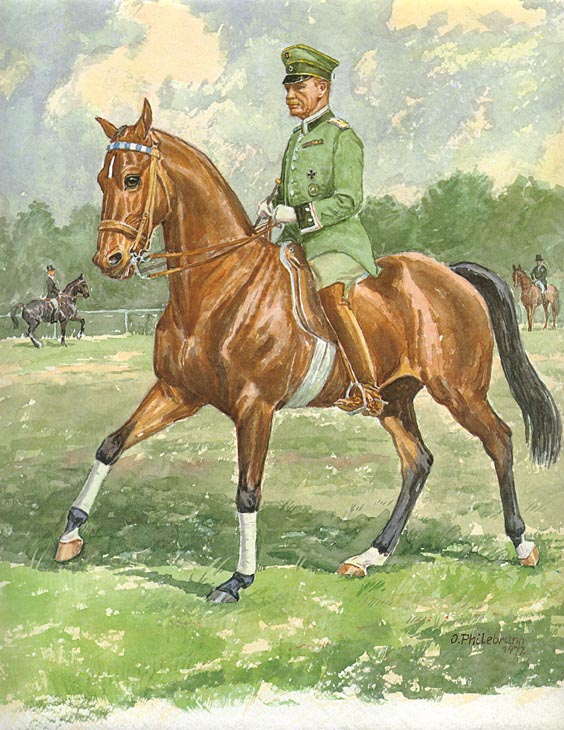
Felix Bürkner with the Thoroughbred, Caracalla. Born in 1883, Bürkner trained at the German Military Riding School in Hannover. He competed at the first Olympic Games, and went on to be one of the most successful riding instructors of the 1920s and 30s. In 1950, he was the first German rider to win an international dressage competition after WW2. He died in 1957, famous for his motto: ‘Life is too short to ride in walk and to smoke bad cigars.’ Bürkner was one of the authors of the modern training scale.
The history of dressage is one of development – it is certainly not static. In Germany, which has been the heart of dressage riding in the twentieth century, the first attempt to codify something like the ‘classical principles’ occurred in 1912 in a Cavalry Manual, this was later expanded in 1937.
I am extremely grateful to Kerstin Niemann of St Georg Magazine who translated this important document for me.
“Here we find the development of the concept of ‘throughness’ – of a contact that is elastic and in a state of changing equilibrium, rather than the Baroque concept where the rein is looped and the horse behind the bit:”
From the Cavalry Manual:
As the straightness improves, the throughness of the horse will improve as well. The pushing capacity of the hindquarters can now go its way through the horse up to the mouth and makes the horse give to the pressure of the bit, bend the neck and chew on the bit.
This is the natural way the horse achieves the correct “going through the poll”. It would not be correct to achieve this “going through the poll” by brutally pulling neck and head of the horse. Instead it must be the result of the hind legs pushing towards the quiet still hand. This is the only way to fix the neck to the wither. And only if the neck is fixed to the wither it is possible to link forehand and hindquarter.
While training a horse, it should never be the way that only separated parts of the horse are worked on, but always the whole horse. Difficulties and disobediences are always connected and will show in either stiffness of the neck, the back and the hindquarters. The rider should always solve those problems with the horse in motion. The rider can gain a false impression that the horse is giving while it is standing still – whereas this wouldn’t happen when the rider lets the horse stride forward energetically.
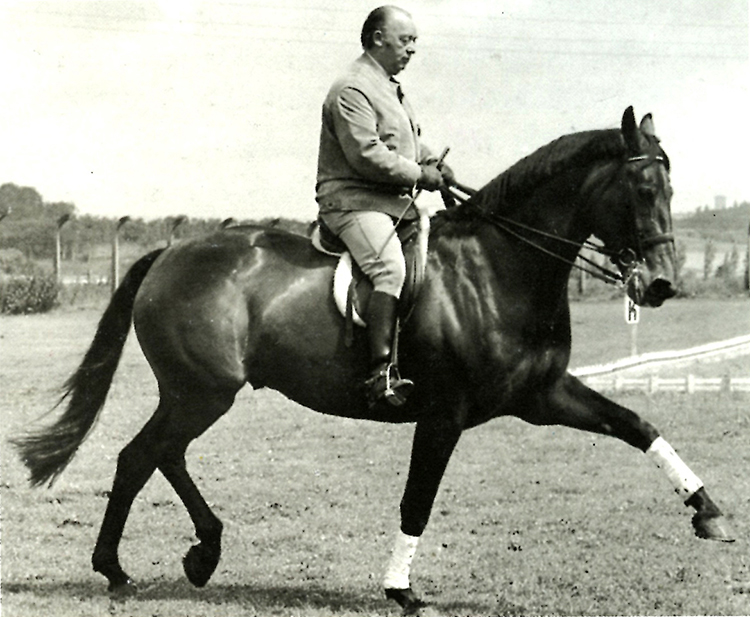
Bubi Gunther and Mazepa. Born in 1921, Bubi and his wife, Maria, were enormously successful in the 60s. In 1963, Bubi became the German male dressage champion in Berlin, while an hour later, Maria won the women’s title.
He was the official trainer of the German dressage team up to his death in 1974.
And later in the document, we find:
Shape/frame for dressage
The best shape of neck and head is the shape that forms when the neck heightens freely out of the wither, and the upper line of the neck builds towards the poll in a soft bend, of which highest point is the poll itself. The head should be held on a straight line from forehead to nose. Such a frame/shape is the right one to allow the rider to best have an effect on the hindquarters. This state of “aufrichtung” (the horse having his poll at its highest point) should only be asked from the horse for short periods of time, and only in halt or in collected gaits. In higher tempo the rider must allow the horse to lengthen the bent neck and to slightly push the nose forward as well.
Kerstin – who is regarded in Germany as an expert on the training scale, included this comment with her translation:
“As you can see, in this chapter you cannot even find the word “training scale”. I therefore had another look through a few of my books and found a few sentences about the development of the training scale. It is found in a new book for professional riders that I worked on with Hannes Müller. This chapter is written by him with a little help from the dressage judge, Angelika Frömming:
I quote:
“The first military riding instruction was published in 1825, but became well-known in the “Heeresdienstvorschrift 1912”. This book was mainly written by the equestrian experts, Redwitz, Lauffer, Felix Bürkner and Hans von Heydebreck. Their ideas based on the knowledge of the earlier authorities, Ayrer, Seeger and, mostly, Gustav Steinbrecht, who wrote a timeless classic book with his “Gymnasium of the Horse” which has been re-written by Hans v. Heydebreck in 1935/36. (The first issue was published after the death of Steinbrecht by a pupil of his in 1886. His name was Paul Plinzner. In this first edition were a few sentences and thoughts which had to be corrected.)
The essence of these earlier writings was then published in 1954 in the first issue of the “guidelines for riding and driving”. In this publication the scale of training still did not have its name, the most remarkable thing was the listing of:
- phase of the horse getting used to everything.
- phase of development of pushing capacity.
- phase of development of carrying capacity.
The scale of riding was first published in the 1980’s. To the first abovementioned phases were added rhythm and Losgelassenheit, these two points were separated in the early 90’s. The listing of these elements shows that “classical” does not at all mean “old”, but it shows a developed, harmonious system. It is known like this all over the world and even the rules of the FEI are based on these ideas.”
Once again, thank you Kerstin for your assistance.
So the ‘timeless’ training scale is in fact, a child of the nineteen eighties…
The late Reiner Klimke who won the World Dressage Championship in 1974, told me that when he started competing in dressage, that coming from a background in eventing, he warmed his horses up firstly in a long free-flowing frame before bringing them up to a competition outline. He said at the time he was one of the first to use this technique which later became standard…
As we can see from the photo, Dr Klimke and Mehmed had a very modern look about them…
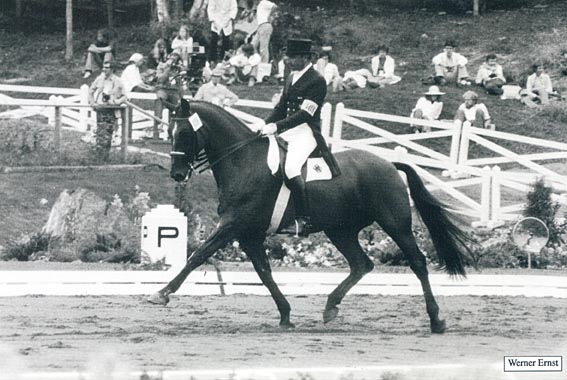
Especially if we compare it with the photo of the World Champions of just four years earlier – Elena Petushkova and Pepel, with their more elevated head carriage and looser rein.
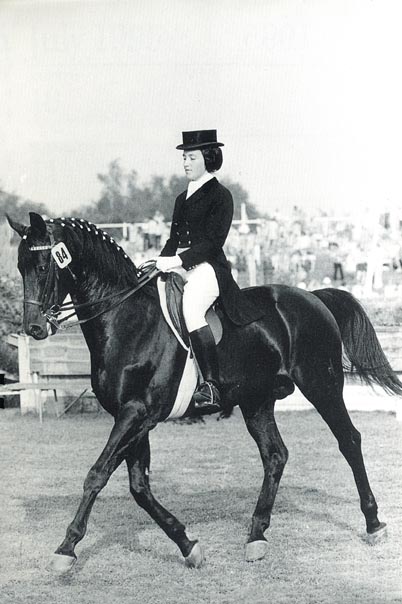
Elena Petushkova and Pepel – World Dressage Champions in 1970
It is my impression that in our desire to find an unbroken historical golden thread of Classical Dressage from the Greeks, to the modern day, we obscure many important ways in which the dressage tradition has developed and matured, and most importantly, the kind of training methods and techniques that are appropriate to the kind of horse we are dealing with have been modified. The furore over the deep and round methods, which started back with Rembrandt and Nicole Uphoff and really took hold with the use of Rolkur by the Dutch riders trained by Sjef Janssen, is merely an indication that consensus on the right way to deal with the current crop of modern dressage horse models, has yet to emerge. Certainly we can be open minded about new techniques, so long as we refer back to that over-riding tradition, that relates every training technique to the horse, its physical and mental properties and well being.
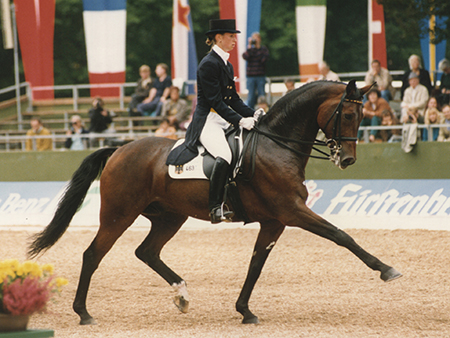
Nicole Uphoff and Rembrandt
We can all think of plenty of examples where the rolkur technique has been used in an unacceptable way – the horse resisting the contact, the rider forced to use strong contact, the horse does not look calm. This to my mind is not acceptable – and to those who feel this whole rollkur debate is simply a German plot to de-rail the Dutch dressage team’s rollercoaster ride to Gold, I can think of a number of occasions where I have seen German riders (including team members) using an unacceptable technique.
The point then is that you can not lay down a geometrically precise series of rules or principles – we must refer to a Classical Tradition, that marries the physical and mental capability of the horse, with the demands of the training or the test – and in these modern times the guardians of this marriage, are the people sitting in the boxes – the judges.
And this is why judges must always be horsemen. When you handle horses every day, you soon learn to recognize tension – tense horses are the ones that can do unexpected things. I know in our country, there are Grand Prix level dressage judges who do not see a horse from one competition to the next. If it looks like a duck, walks like a duck, quacks like a duck, it probably is a duck. If a horse won’t halt, is covered in sweat, irregular in its movement, has its ears back and switches its tail, then the chances are that it is tense – and if Olympic level judges can’t see that, then they have no business judging. There are plenty of horsemen in the ranks of the spectators who can see what is invisible to the Ground Jury.
This – for mine – is the crux of the matter. While we have seen huge advances in training techniques built on a body of highly intelligent and insightful theory, the attempt to judge and score dressage on some sort of objective scale, is a recent project and one that has more often failed than it has succeeded.
At each Olympic Games, from 1912 to the present day, the judging in the dressage has given rise to huge controversy.
Perhaps then just as we have seen that the progress of the sport has been driven by changes in the breeding of the dressage horse, we need to look similarly to our judges – are we selecting on the basis of the best gene pool available? Are middle aged ladies with incomes large enough to allow them to travel to the plum jobs and then show the diplomatic skills that see the ‘right’ result emerge, necessarily the breed we want in judges boxes?
Or are we going to have to finance judges who are also knowledgeable horsemen to take over this role, if we are to see the classical tradition flourish on the scoreboard and in the medal count of this the twenty first century?
Our horses continue to improve every year, our rider techniques become more and more refined, watching dressage tests should be a source of increasing joy – and it will be, if we can find a way to ensure that those who get the highest marks are those who conscientiously relate their demands to the capacity of the horse.
I believe that the classical tradition will survive, but it will not survive if it is frozen into being a museum exhibit – to survive it must be a living organism, that is always in a state of evolution. I look forward to those developments that increase the beauty and grace of the performance, We must continue to speak out against techniques that are harsh and restrictive. In other words, we are back where we started, with those words of Xenophon:
‘For what the horse does under compulsion… is done without understanding; and there is no beauty in it either, any more than if one should whip and spur a dancer.’
To that, amen.
Postscript:
The world of dressage is improving. The practice of Rolkur has largely disappeared, defeated not so much by an attack of conscience or good taste, but in the dressage arena, where the judges have tended – not always – to favour harmonious dressage rather than the spectacular style that marked the Dutch school.
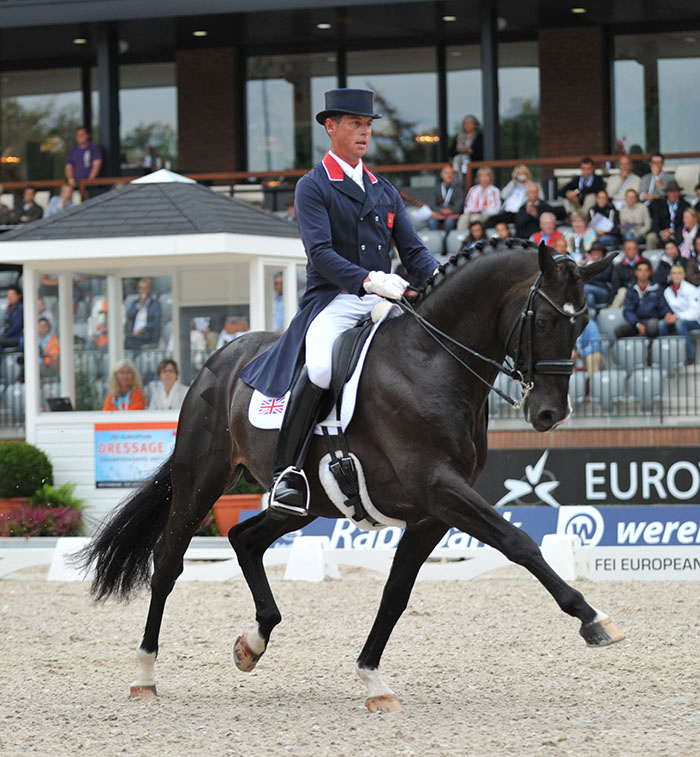
Carl and Uthopia at Rotterdam – harmonious dressage can be winning dressage…
It started ten years ago at the European Championships of 2011, where Carl Hester and Uthopia and Charlotte Dujardin and the new star, Valegro ushered in a era of elegantly correct dressage.
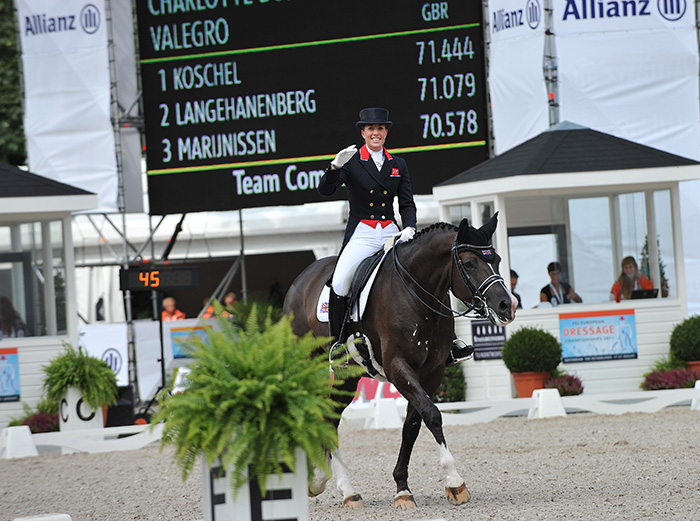
The new stars emerge at Rotterdam – Charlotte and Valegro
Spectacular wasn’t just unpleasant to watch, in the ring, and particularly in the warm up, but it was no longer a winner. It became very difficult to find a judge who liked ‘spectacular’, strange then that Anky and Salinero had collected so many medals…
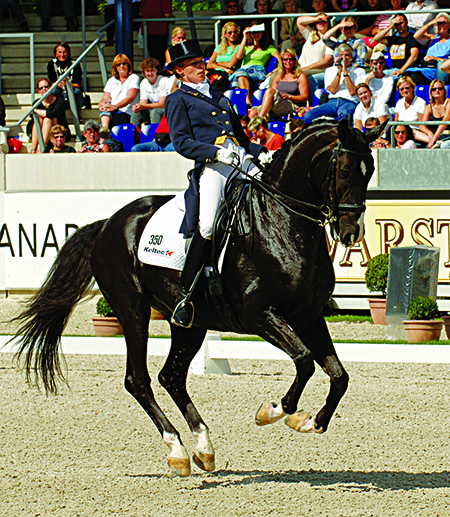
Anky and Salinero up the centre line – not a pretty picture
The situation has continued to improve. The current German team riders are very correct and attractive in their riding style: Ingrid Klimke, Jessica von Bredow-Werndl, Sönke Rothenberger and Isabell Werth all currently riding very stylishly and successfully.
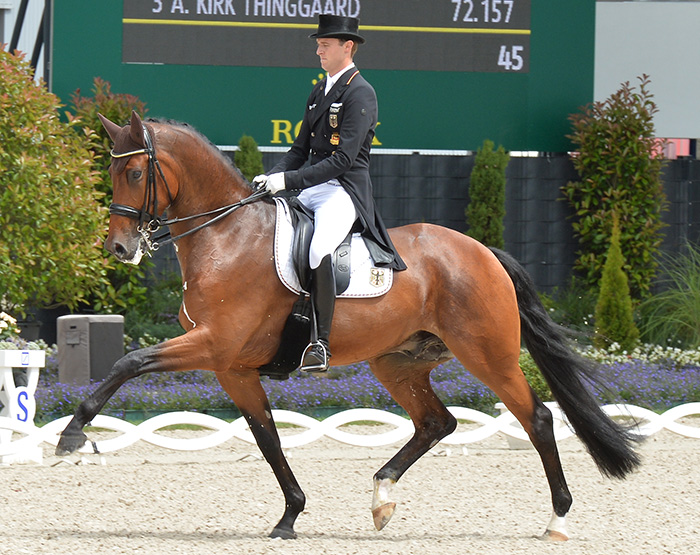
Sönke and Cosmo – such a stylish combination …
Add to this the influence of the Americans. Robert Dover as team coach has been a life-long advocate of civilised riding, and his successor as coach, Debbie McDonald, has taken elegant effectiveness to new heights with riders like Laura Graves, Adrienne Lyle, Kasey Perry-Glass and more…
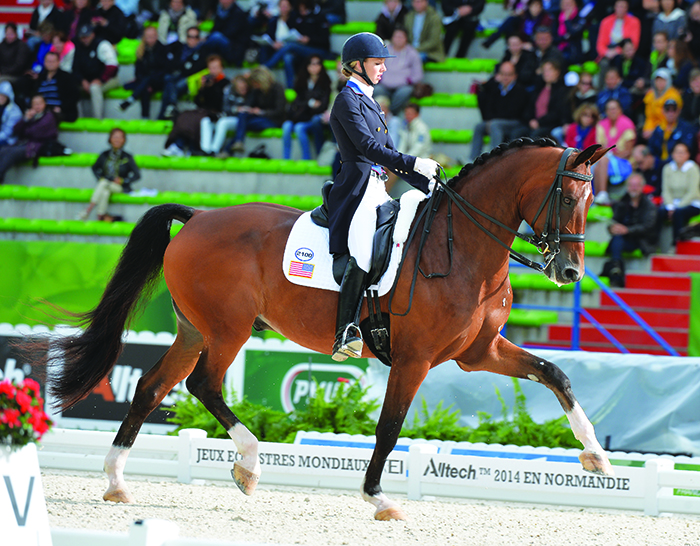
Laura and Verdades – harmony is the way to go…
At Aachen, there is now special information steward in place for the warmups in the main dressage arena in case worried or puzzled spectators wished to discuss what was happening with the horses, but I think he had nothing to do. Sure there will always be some riders who do it better, nicer, than others, but I sat there for all the warmups and saw nothing that was ugly, certainly nothing as ugly as the performances of years gone by, where at one stage the warm up arena was closed so we couldn’t get bad pictures of Anky warming up… but we did:
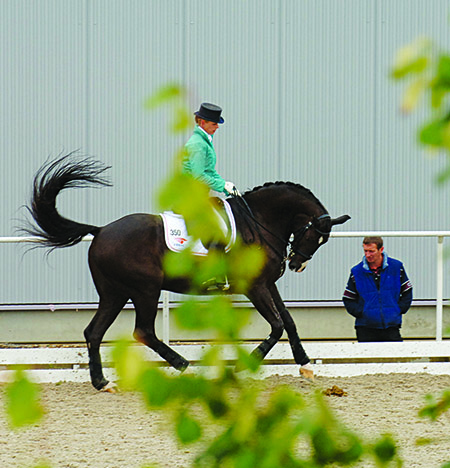
This year in the same arena you were more likely to see something like this:
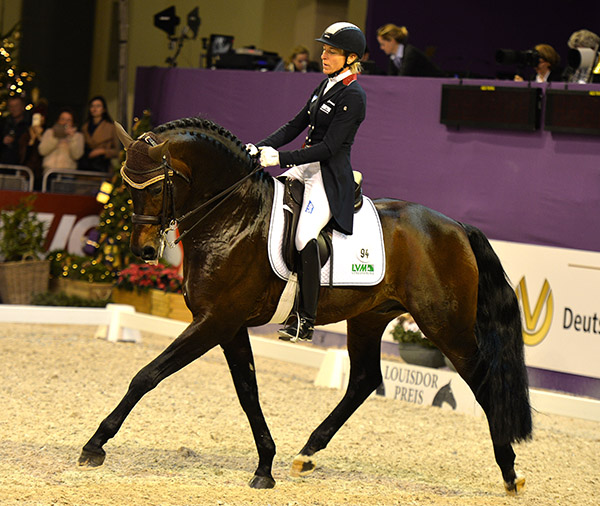
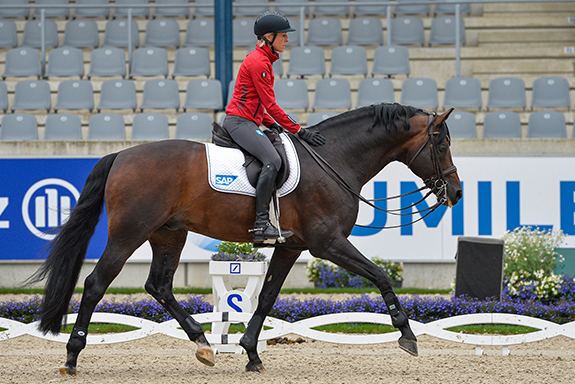
Ingrid Klimke and Franziskus (Photo: Becker / Equitaris)
And if the above photos give us some feel of where dressage is going, you would have to say it is moving to a pretty good place…
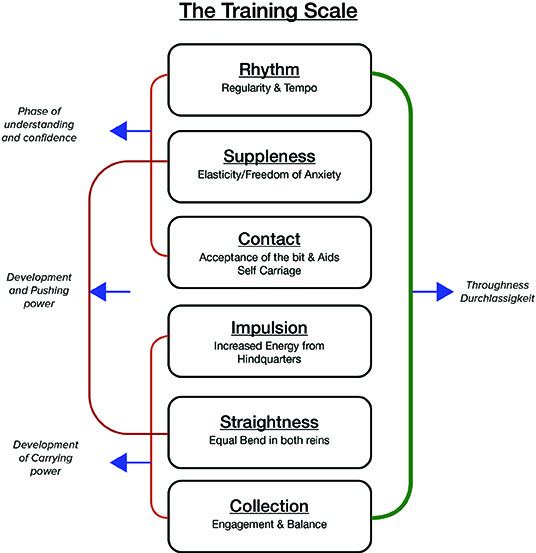
Breeding a modern dressage star in Australia this season? Go to www.ihb.com.au and select from the top European Bloodlines available in Australia
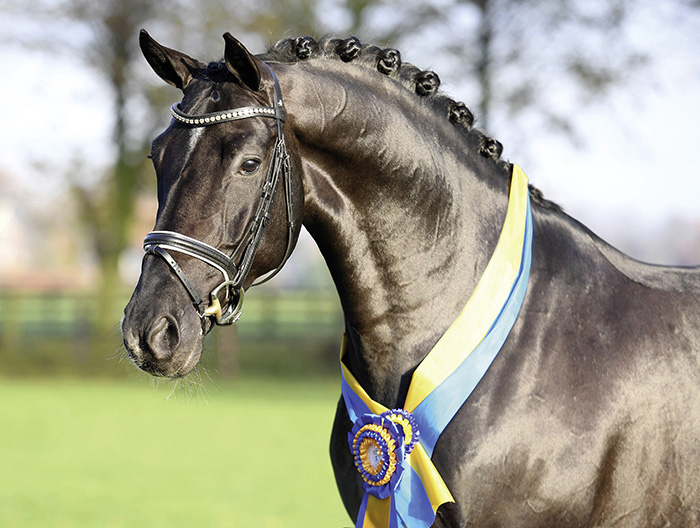 Total Hope
Total Hope
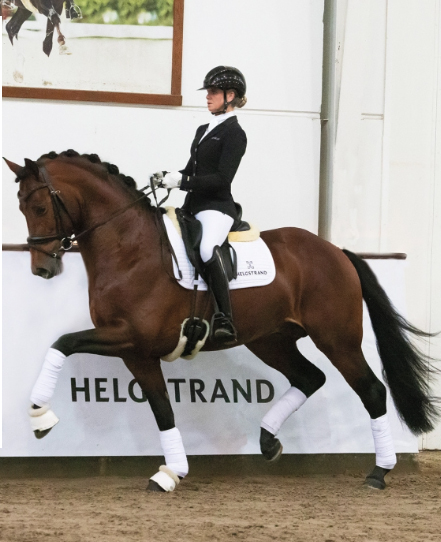
About You II
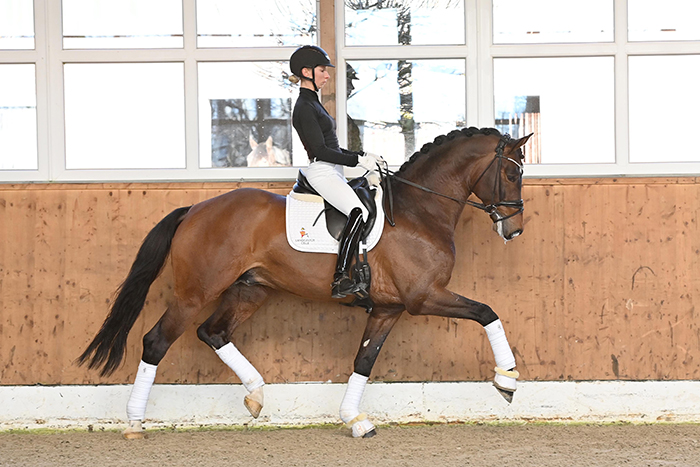
Fusionist


The German Cavalry Training Manual HDV12/1937 is now available in an English translation. Please find it on Amazon or at Xenophon Press. The 1937 version is the one that serves as the basis for today’s Training Scale and today’s FN Principles of Riding. Enjoy! http://www.amazon.com/H-Dv-German-Cavalry-Manual/dp/0933316518
Who is the author of this article ?
christopher hector
This is how I was taught from the beginning, occasionally over the years being led astray out of naivety. Trainers and judges have huge responsibility, as us happy amateurs are like lambs to the slaughter.
Its common sense that a judge is a rider with a percentage more knowledge than she/he is judging, that way the feel is clear along with detail of how the horse is being ridden, and the state of the horse while its being ridden. So maybe sometimes common sense is missing? in this sport.
“As I write, October 2019, the world of dressage is looking fine. The practice of Rolkur has largely disappeared, defeated not so much by an attack of conscience or good taste, but in the dressage arena, where the judges have tended – not always – to favour harmonious dressage rather than the spectacular style that marked the Dutch school.” Christopher Hector.
I think in truth this change has come from social license – from those that will not accept the abusive practices of Rollkur and also BTV riding… which we still see creeping through along with exaggerated hoof flicking.
A good walk says it all.
Good article. Credit to everyone that speaks up for the horse
Another interesting and illuminating series that caused more than a few light bulb moments and has helped me understand much more the journey that I am undertaking with my horse.
If it were not a huge amount of money for many, in the unhealth of the horses, maybe it would be more interesting to look closer at the fact of what is causing a lack of balance and self carriage, AND ortophedic injuries (!) in our horses today!
Horses with self carriage have heels, and not flared or high toes. Today horses are trimmed to having their weight in the back of the hoof, on the heels! And this is what is told at the farriery school,
low heels – high toes…. THE HORSE JUST CAN NOT BE UP IF THE HOOVES ARE DOWN..!!!
Dear Mr Hector…Unfortunately there are very few alive today who have witnessd horses being ridden in a frame of “harmonious lightness” with the rider sitting effortlessly centred. How sad it is for the horses/riders that you publish this article promoting the “incorrect” German Training Scale. The teaching of “Lightness” was abandoned by the germans as too time consuming and technical in our fast modern world of competitive dressage. Thank goodness “some” of the french masters perfected the technique which has been passed down and has not been lost! . Alas today since the mass introduction of “misguided” popular accredited teaching programs students are in the dark not too also mention their teachers! I am 70 years old and started training at age 12 with those who followed the french classical system. I also travelled to Portugal to train with the late genius Mestre Nuno Oliveria who was a genius in “Lightness”and also followed the french system. . He often expressed to me how ugly dressage had become seeing elite competitors riding forcefully horses in such compressed unharmonious outlines…..Michele Holiastos …founding member Dressage Association NSW.
The Scale of training is not born out of the eighties. Before the eighties, it was handed over by world of mouth that is all.. From master to pupil, as it should. Without proper teaching supporting the words, words are meaningless. See for example how 99% of riders have no idea what true Losgelassenheit means: most now think it mean the horse has a supple neck, or floppy neck (even worse).
Mr Hector. The only good dressage is when the presentation and the judging is according the FEI-rules. In those rules there is no place for hectic and spastic demonstrations but is all about takt, ritm and balane. Since the terrible inbalanced and hectic performance from the rollkurqueen Anky the incompetent judges have awarded inbalane and disharmony.. So we need to go back to the basics and we need competent judges and riders.